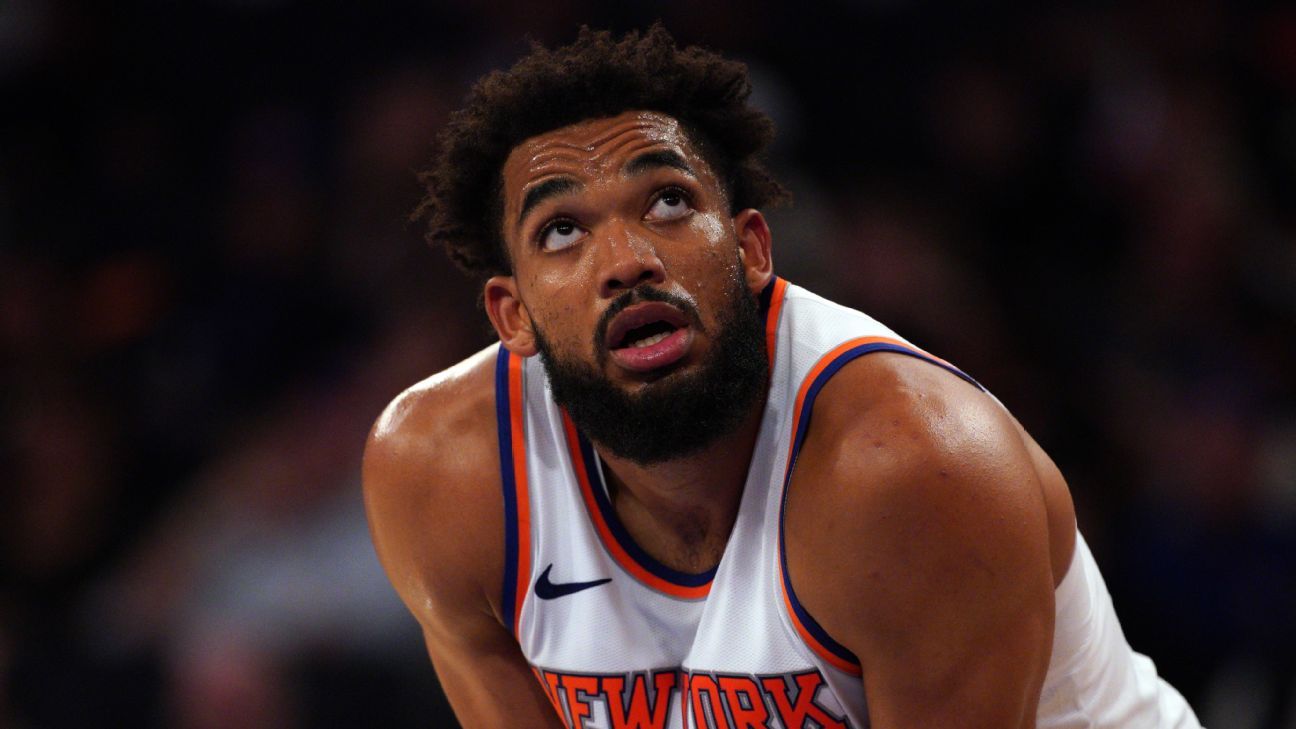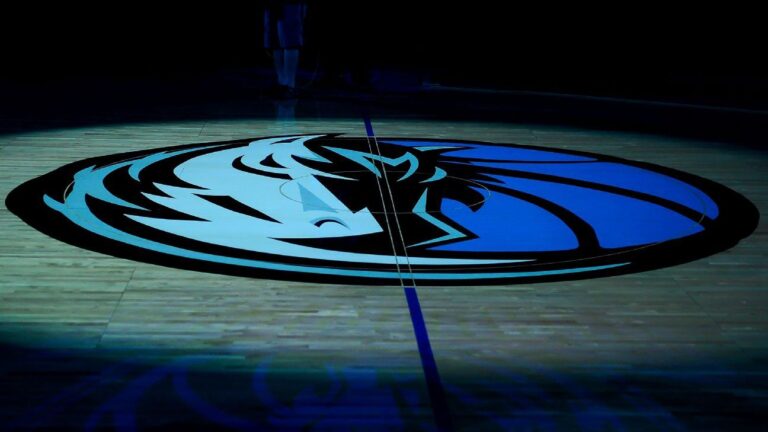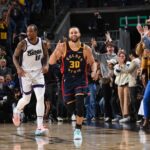-
Brian Windhorst, ESPN Senior WriterOct 11, 2024, 08:00 AM ET
- ESPN.com NBA writer since 2010
- Covered Cleveland Cavs for seven years
- Author of two books
Get Karl-Anthony Towns and $300,000 to spare.
For the New York Knicks, this was the mandate and the margin.
Towns and his new Knicks teammates will see his old team, the Minnesota Timberwolves, Sunday (6 p.m. ET on ESPN) in what has become one of the most interesting games of the preseason. The machinations that decided which uniform Towns would be wearing are deeply nuanced and endlessly interesting.
Acquiring Towns was a blockbuster. What the Knicks did to actually make it happen was a saga.
That’s where the $300,000 comes in. That is how much space the Knicks will have below the unbreakable barrier known as the “second apron” once they fill out their roster at the end of the preseason, league sources told ESPN (because they aggregated salaries in the trades to acquire Towns and Mikal Bridges, they are not allowed to exceed the second apron at any point this season). This is roughly 0.2% of their $189 million payroll this season, by NBA contract standards a rounding figure. But what a dance to get there.
Editor’s Picks
2 Related
“It’s been great execution of a plan. It’s five years in the making,” Knicks coach Tom Thibodeau said. “It’s accumulating the draft capital, and looking at the opportunities and going step by step and figuring out the things you can do.”
Like this:
-
In 2021, the Knicks signed Jalen Brunson to a contract that descended over the first three seasons. Even though he signed a new four-year, $156 million deal that will begin in 2025, Brunson’s contract declined by $1.3 million from last season to this season.
-
In 2022, the Knicks signed Mitchell Robinson to a contract that descended over the four years of the deal. Robinson’s salary declined $1.3 million from last season to this season.
-
In June, the Knicks declined to extend center Precious Achiuwa a qualifying offer of $6.3 million, which would have made him a restricted free agent. Instead, they allowed him to enter unrestricted free agency. Then, a month later, they signed him to a contract for $6 million to be their backup center. It saved $300,000 in cap space over what he would’ve cost them if they’d extended the qualifying offer and he’d signed it.
-
The Knicks started draft night with two first-round picks, Nos. 24 and 25. They then made six draft night trades, ultimately ending up with picks No. 25 and No. 34 in addition to a handful of other second-rounders, most of them for future drafts.
-
Their first-round pick, Pacome Dadiet, signed a contract at 80% of his preassigned salary slot for the first year, which is allowed by rule. Their second-round pick, Tyler Kolek, signed for $800,000 less than the 24th pick’s salary slot. These maneuvers saved the Knicks $1.3 million in cap space for this season.
-
The Knicks signed-and-traded three players — Charlie Brown Jr., DaQuan Jeffries and Duane Washington Jr. — to the Charlotte Hornets to make the deal work under the apron rules Minnesota and New York had to deal with. The Knicks signed them to contracts totaling $6.8 million to make the trade workable. Then they used the $7.2 million NBA teams are allowed to send out in trades per year and sent it to Charlotte, covering the cost of the players with the Hornets making $400,000 profit plus three second-round picks. The Knicks were only allowed to sign-and-trade Jeffries because they’d signed him to a rest-of-season contract (after two 10-day contracts) on March 25. Washington and Brown both ended last season with the Knicks on two-way deals, making them sign-and-trade eligible.
Without every single one of these moves, the Knicks would not have been able to make the Towns trade. All of it together made it happen. Some of them, such as the rare triple sign-and-trade, were for Towns. Others, like the contract structures for Brunson and Robinson, were put in place just in case something like this was needed.
Knicks president Leon Rose, who was obsessed with acquiring Towns, went down a similar path with a previous offseason obsession: getting Brunson in 2021. A former client from his agent days like Towns, Brunson was a target of the Knicks for months and they made a series of deals around the draft that year to clear off $30 million from their books to open the cap space to sign Brunson outright.
Sunday, Oct. 13
Timberwolves at Knicks, 6 p.m.
Suns at Nuggets, 8:30 p.m.
Friday, Oct. 18
Lakers at Warriors, 10:30 p.m. (ESPN2)
All times Eastern
The Dallas Mavericks, Brunson’s old team, were sufficiently caught off guard in losing him without a chance to match or trade. They later filed tampering charges against the Knicks after seeing the symphony end with Brunson agreeing to terms at the very start of free agency (the Knicks were docked a second-round pick in the 2025 draft as a result of that tampering investigation).
If that was graduate-level front office work, the maneuvers to land Towns, who Rose says could be his other cornerstone, were a thesis.
The nuts and bolts were largely performed by Knicks vice president of strategic planning Brock Aller, who has a long history of making multistep complex deals dating to his days in the Cleveland Cavaliers‘ front office. Aller handles much of the strategic moves for the Knicks and does most of the complex trade negotiations.
“Brock has been terrific,” said Thibodeau, who previously ran the Timberwolves’ front office. “And it’s not easy. It’s your immediate plan and also your future plan. You have to look at it in almost three different ways. There’s the basketball standpoint, what does it mean for what’s on the floor? Then there’s the financial impact. Then there’s also the penalty aspect that you have to look at as well. So all three things before you make a decision you have to dig deep on. So they’ve done a great job.”
Essential Fantasy Basketball Content
• Fantasy basketball 101: How to play
• 10 tips to win your league
• Projections | Top 150 rankings
• Experts: Our five favorite draft targets
• Mock draft: 10-team H2H points league
Towns knew Rose was interested in getting him but he didn’t think the Knicks could pull it off, not after his salary jumped by $13 million starting July 1 as his supermax contract extension signed in 2022 kicked in. Or after the Knicks triggered a series of trade restrictions once they made another massive deal, landing Mikal Bridges, in June.
“I was shocked,” Towns said. “Maybe the word flabbergasted is more correct.”
So was much of the rest of the NBA. But Rose, Aller and the rest of the Knicks’ front office, including vice president Gersson Rosas, who helped put the big trade with his former team together, can only do so much. The players are aware the serious business is still in their hands.
“[Brock] does a great job on his part,” Brunson said. “We applaud him for it, and we’ve just got to go out there and do our part on the floor.”







